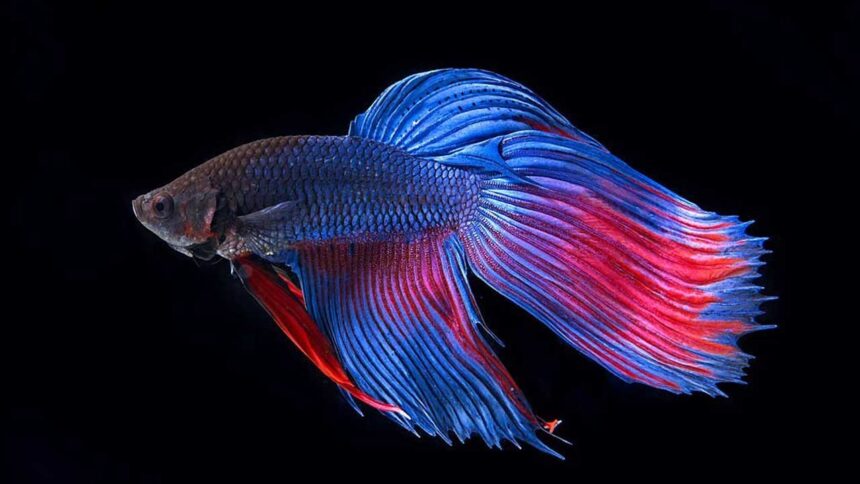Description and characteristics of the betta fish, fighting fish, or siamese fighter
The betta or Siamese fighting fish (Betta splendens) is a popular aquarium fish of great beauty.
They reach 6 cm in length in the case of males and 5.5 cm in the case of females. They can live about 2 or 3 years.
The male betta fish
Males have highly developed and spectacular dorsal, caudal and anal fins.
There are numerous varieties of beautiful colors, including red, white, blue, yellow, chocolate, orange, black, etc., obtained by breeders.
female betta fish
The females are more discreet in this sense, and their fins do not reach the spectacularity of the males.
wild betta fish
Wild specimens have much duller colors and less developed fins. Males are reddish-brown with some green lines, and females are yellowish-brown.
Biology of the fighting or fighting fish
The Siamese wrestler has an organ called a labyrinth that allows it to breathe oxygen from the air, thanks to which it can survive in oxygen-poor waters. It is an aggressive species with its congeners. The males do not tolerate each other and engage in violent combat when they meet until the defeated one flees. The females, on the other hand, have a tolerant character.
Betta fish reproduction
During reproduction, the male tries to win over the female by displaying his fins while swimming around her. Receptive females darken their body color, now showing darker vertical lines.
The males build bubble nests attached to rocks, roots, leaves, and stems, which cross the water’s surface. The female lays eggs, turning her belly up, while the male fertilizes them by embracing her with her body. Fertilization is external.
After completing the laying, the male expels the female, who could devour the eggs and takes care of the offspring. If an egg sinks, the male picks it up with his mouth and deposits it in the nest.
Incubation lasts two to three days, and the fry sremains another two to three days in the nest while the male consumes and protects the yolk sac. They then leave the nest and parental care.
What does the Siamese fighter eat?
They feed mainly on small invertebrates, insect larvae, zooplankton, etc.
Habitat and distribution of Betta splendens
It lives in slow-flowing or stagnant waters, rice fields, flood zones, etc.
It is an endemic species of Thailand, specifically in the basins of the Mae Khlong and Chao Phraya rivers, where it is increasingly scarce.
Aquarium betta fish care
Siamese fighters, especially males, are among the most attractive freshwater aquarium fish. But you should not have more than one male per aquarium since they are very aggressive with each other. Not having space to flee, one of the two would end up dying.
Nor is it entirely advisable to have a partner since the male can chase a non-receptive female until she is exhausted. The females, however, can share an aquarium without problems if they have enough space. Otherwise, they can also become aggressive. They can also share it with other species, although they could become aggressive with small species with bright colors and developed fins, such as guppies.
How to feed your Siamese fighter well
Betta fish are not fond of commercial flake food, so it’s a good idea to offer live food such as mosquito larvae or daphnia frequently.
What is the right aquarium for betta fish?
It is not very demanding regarding the size of the aquariums. However, although it could perfectly live in a 20-liter aquarium, a 45-liter tank is better if it is shared with other species if it develops territorial behaviors. Prefers depths of less than 40 cm. The water temperature must be between 24º and 29ºC; the pH is around 7, and semi-hard or hard water.
The aquarium will be well planted because this fish likes to hide among the algae. It should also be covered, as it wants to jump, and we will, maintain the temperature and humidity of the air over the water, which will prevent the labyrinth from inflaming when it breathes air.
How to get betta fish to reproduce
The bettas will be placed in an aquarium of about 20 liters with a temperature of 20 -30ºC separated by a glass, or the female will be divided in a separate container inside the aquarium. This will stimulate the building of the bubble nest by the male. You can offer him something floating to attach the nest to that element instead of the female’s container.
Once the nest is made, the female is released. She must retire after laying since the male takes care of the eggs and the fry. For its part, the male will retire three or four days after hatching. The fry will be fed brine shrimp and infusoria.
Taxonomic classification of Betta splendens
Kingdom: Animal; Phylum: Chordates (Chordata) – Subphylum: Vertebrata; class: Actinopterygii (bony fishes); order: Perciformes; family: Osphronemidae; genus: Betta; species: splendens.
Scientific name : Betta splendens
Common Names: Fighter, brawler, fighting fish, siamese fighter, betta fish
What is the betta fish or Siamese fighter called in other languages?
English: siamese fighting fish, betta; German: siamesische kampffisch; French: combattant; Italian: pesce combattente, pesce siamese combattente; Portuguese: peixe betta, peixe de briga Siamese, wrestler, combatant.








